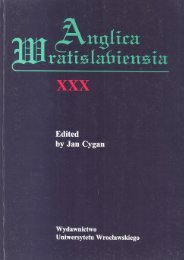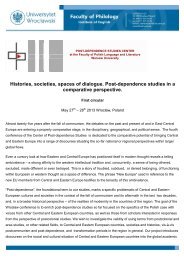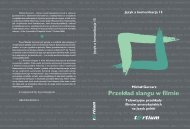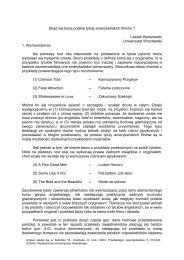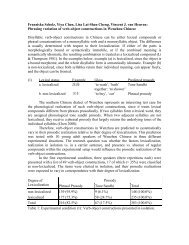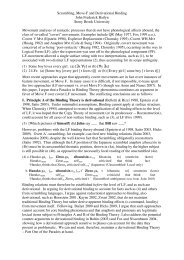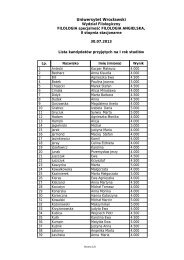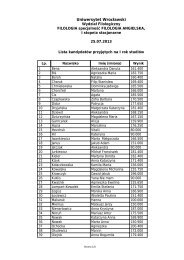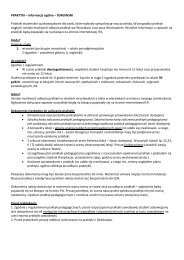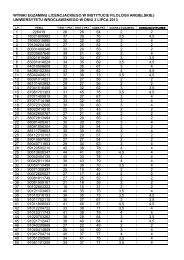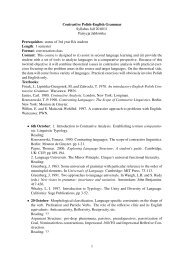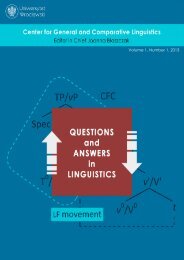Academic Journal Modern Philology
Academic Journal Modern Philology
Academic Journal Modern Philology
You also want an ePaper? Increase the reach of your titles
YUMPU automatically turns print PDFs into web optimized ePapers that Google loves.
Non-formal Elements in <strong>Academic</strong> Translator Education<br />
measuring of all the effects of the educational process. Unlike e.g. Shreve (1995: xiv), who stated that “to<br />
build the competence we want in our students we have to design precise pedagogical tools – tools for<br />
particular purposes that will yield specific desired effects,” is not an advocate of a radically linear, effectdriven<br />
concept of translator education. Take the above-mentioned idea of transformative learning for<br />
example: is it feasible to assume that the effects of such a transformation can be measured? Consequently,<br />
the formal curriculum must allow for “unplanned” results. 6 At the same time, the non-formal approach<br />
to education is flexible enough to employ planned problem-based learning, tuition or facilitation and<br />
project work leading to material results (publication). Also, the non-formal framework can also make a<br />
good use of collaborative learning.<br />
The above arguments are meant to demonstrate that, apart from the radical, contrastive stance that<br />
sees non-formal education as superior to the formal one, an integrated view is possible under which the<br />
formal and the non-formal approaches merge. This view is represented in the literature of the subject e.g.<br />
by Billett (2001), who claims that the distinction between formal and non-formal learning is, in fact, false.<br />
On the one hand, Billett confirms Eraut’s claim that learning takes place predominantly in a non-formal<br />
environment. On the other hand, Billett asserts that learning always takes places in some form of formal<br />
(social) context: school, work, home or church. Thus, the formal and non-formal coincide and they must<br />
be seen as the two faces of one coin.<br />
Concluding this section, the author states that a number of researchers express their awareness that<br />
the formal curriculum on its own does not do the justice to the educational needs of the present-day adult<br />
learner. Some of the researchers argue that the sooner the curriculum becomes less formal, non-formal<br />
or self-directed (informal), the better for the learners, educators and the society at large (Eraut 2000;<br />
Hayse and Kenyon 2000). Others opt for merging the formal and the non-formal aspects of learning and<br />
education (Billett 2001). Both these approaches serve as the basis for the proposals made by the author<br />
in what follows.<br />
39<br />
Non-formal elements in support of the formal curriculum<br />
With all the observations made so far in this paper, the author wishes to proceed to his own theoretical<br />
and practical proposals concerning the introduction of non-formal elements into the formal framework<br />
of translator education. Drawing upon the research reported above, the author proposes that curriculum<br />
designers should plan a non-formal ‘programme’ of initiatives running parallel to the formal academic<br />
curriculum. These initiatives are not only to accompany the curriculum, but also to be an element of it.<br />
The proposal put here is that they should be integrated with the formal curriculum more closely and more<br />
purposefully. They can influence the way the formal curriculum is planned and realized (some formal<br />
content may be moved to the non-formal area), or may serve as a ‘testing ground’ for certain educational<br />
solutions that the teachers may need to observe in a non-formal context before implementing them in the<br />
classroom.<br />
Table 3 below sums up the major areas in which the formal curriculum can gain support from the<br />
non-formal programme.<br />
6 See the concept of the ‘double loop learning’, as quoted above from Hase and Kenyon (2000:5).



